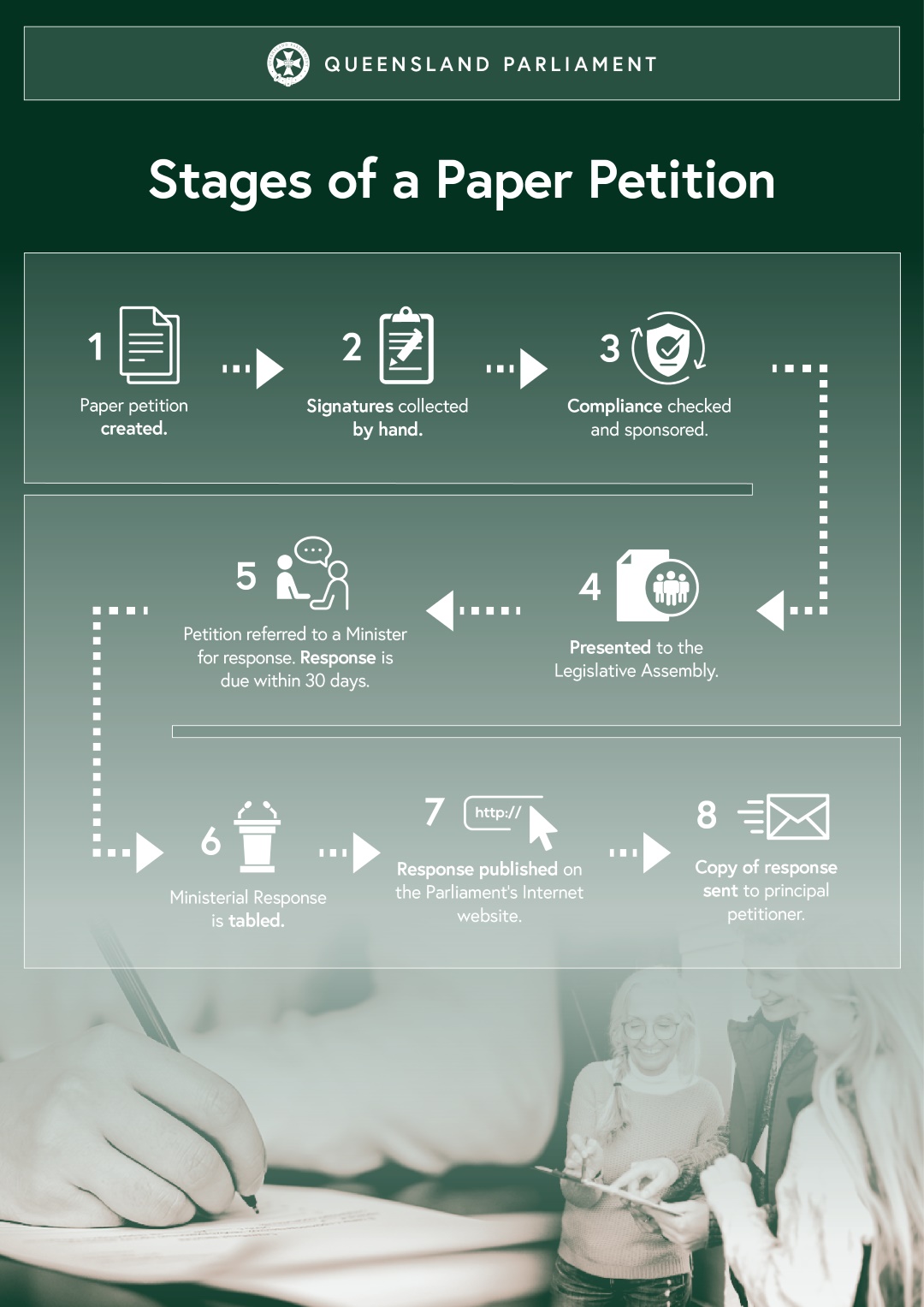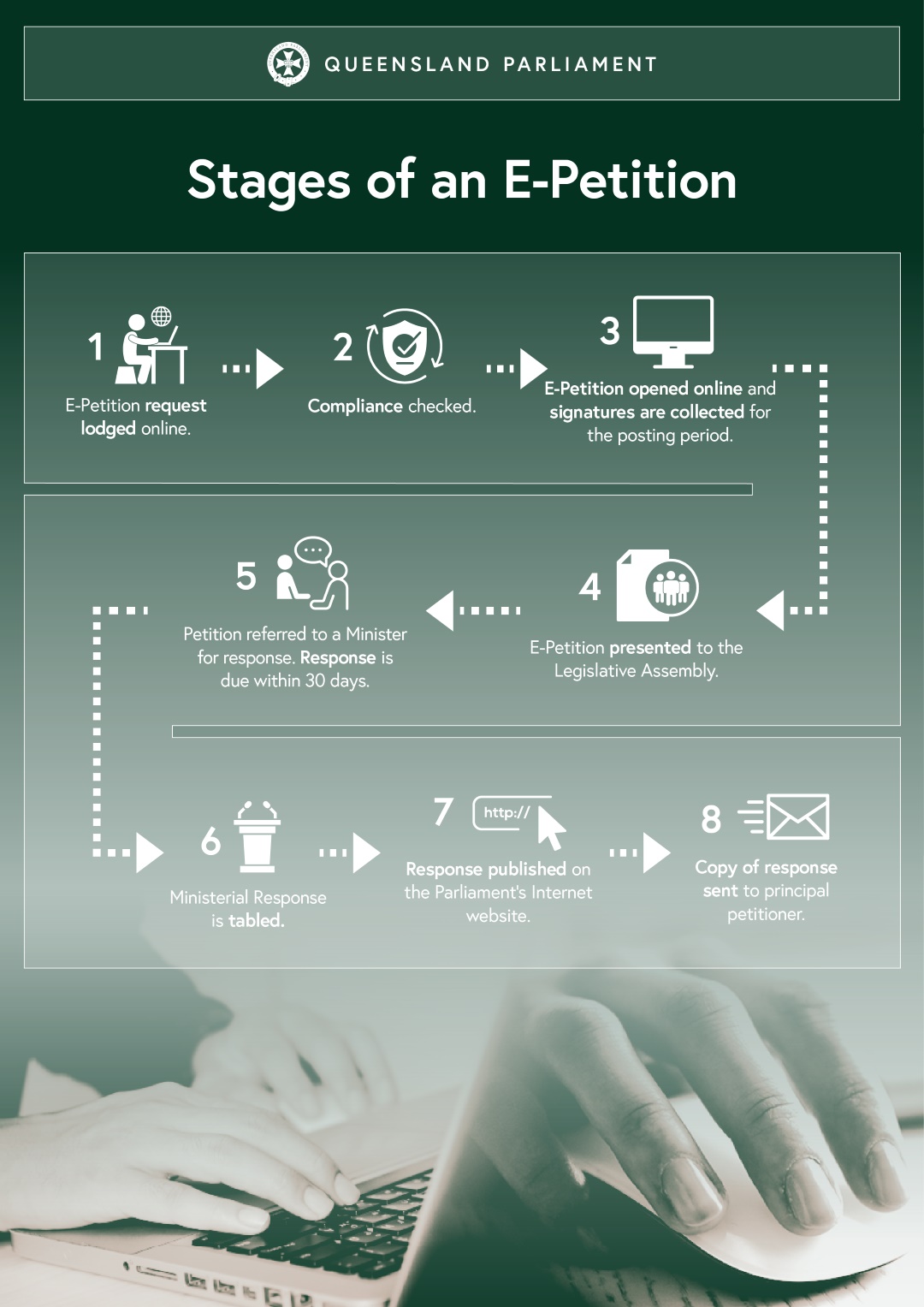ON THIS PAGE
What is a petition?
A petition is a formal request signed by at least one person and placed before the Legislative Assembly with the intention of persuading the Legislative Assembly to take some particular action. Petitioning is one of the traditional methods by which members of the public can make a formal request directly to the Parliament. Petitions are a way for Queenslanders to express their views, voice problems and request action from the Queensland Parliament. Petitions may, for example, request the alteration of a law or the reconsideration of some administrative decision, or press for the redress of local or personal grievances.
The Legislative Assembly of Queensland recognises two types of petitions:
- Paper petitions; and
- Electronic petitions (E-Petitions)
A Paper Petition or E-Petition to the Legislative Assembly of Queensland must:
- State a concern/issue (grievance),
- Ask the House to take action to improve the situation (action required),
- Be signed by at least one person, and
- Lodged with The Clerk of the Parliament.
Until 2003, petitions were only possible in paper form. The Queensland Parliament introduced online petitioning in 2002 and these petitions submitted in electronic format are referred to as ‘E-Petitions.
From petitions.rulesandinformation.golivedate, Queenslanders can lodge E-Petition requests on the Queensland Parliament website.
Only E-Petitions hosted by the Queensland Parliament's website are deemed E-Petitions to the Legislative Assembly. Online petitions hosted on other websites are considered non-conforming petitions.
Who can start a petition?
You must be a resident of the state to start a petition to the Legislative Assembly of Queensland. You must outline a problem or grievance that you have, and then whatever action you are asking the Parliament to take, within 250 words.
E-Petitions do not replace the paper petition process. If you wish to start a petition you can choose to circulate either a paper petition or an E-petition. You will also have the option of running both processes in order to reach the widest audience.
Only one E-Petition dealing with substantially the same grievance and requesting substantially the same action by the House can be posted to the Parliament's website. However, a paper petition and an E-Petition on the same topic can run concurrently.
Who can sign a petition?
People who can petition the Queensland Parliament, as set out in the Standing Orders include:
- Queensland residents;
- Queensland citizens;
- or Queensland electors (the relevant state division will be specified on the petition).
The principal petitioner will identify who might have an interest in and want to support the petition and the eligibility category will be identified on the website.
Persons must sign paper petitions by their names or marks, filling out correct details and no one else, except in case of incapacity from sickness.
If you wish to join an E-Petition, you will need to accept the E-petition’s Conditions of Use, which outline: the eligibility requirements; the requirement that a person may only join an E-petition once; and the prohibition on the use of false names.
Rules
Standing Orders provide the following general rules for petitions:
- A petition shall be in the English language, or if in another language shall be accompanied by an English translation, certified by the member who sponsors or lodges it to be a true and correct translation.
- The grievance and action required on each petition cannot exceed 250 words.
- A petition of a company must be made under its common seal (if the company has a common seal).
- Letters, affidavits, or other documents may not be attached to a petition and, in the case of e-petitions, no reference to URLs or other links or web-based references are permitted.
- A petition must be respectful, decorous and temperate and not contain any unparliamentary language or otherwise offend any rule or practice of the House.
- Application shall not be made by a petition for any grant of public money, nor for compounding debts due to the Crown, nor for the remission of duties payable by any person, unless it is first recommended by the Governor.
- In respect of paper petitions, signatures shall be written upon the petition itself, and not pasted upon it, or otherwise affixed or transferred to it.
- Persons must sign paper petitions by their names or marks, and by no one else's, except in case of incapacity from sickness.
- Persons must join an e-petition by filling out their correct details and personally agreeing to join the e-petition, and by no one else, except in case of incapacity from sickness.
- A person cannot sign or join the same paper petition or e-petition more than once.
- The correct form of the petition (including the name, address and, in the case of an e-petition, the email address of the principal petitioner) must appear on each page of the petition to be presented to the House.
How are paper petitions started?
The paper petitions process is essentially the same petitions process that has been operating in Queensland for over 140 years. It involves a paper petition being circulated in the community for signatures and then lodged by a member or the Clerk of Parliament.
Lodging Paper Petitions
A paper petition must be lodged by a Member of the Legislative Assembly or the Clerk of the Parliament. Usually, the Speaker does not lodge petitions for presentation to the House.
The Member of Parliament or the Clerk of the Parliament ensures that the petition conforms with the rules. The Member or the Clerk of the Parliament places their signature on the top of the first page of the petition and indicates the total number of signatures contained in the petition.
If a Member is lodging a petition, it must be lodged with the Clerk at least two hours prior to the sitting of the House in which the petition is to be presented.

How are E-Petitions started?
The key difference between the paper-based and electronic process for petitions relates to how the process starts. The online form is used to lodge the E-Petition records the wording of the E-Petition; the eligibility category; how long the E-Petition will be open and the principal petitioner’s name and address.
The Clerk of the Parliament may request changes to the petition wording before approving the E-Petition. You can request any member of the Queensland Parliament to sponsor your petition, it does not need to be your local member nor does it mean the member agrees with your petition. Under current Standing Orders, there is no obligation for members to sponsor your petition. The Clerk is available to sponsor your E-Petition.
Only E-Petitions hosted by the Queensland Parliament's website are deemed E-Petitions to the Legislative Assembly. Online petitions hosted on other websites are considered non-conforming petitions.
Step 2: Compliance Checking
The Clerk of the Parliament will check that it meets the requirements set out in the Standing Orders. If these requirements are satisfied, the E-Petition is posted on the website until the specified closing date.
To comply with Standing Orders, the Clerk may require an amendment to the E-Petition before posting.

How long can an E-Petition be posted on the website?
An E-Petition can be posted on the website for a minimum period of one week and a maximum period of six months. The Principal Petitioner decides the posting period.
Who will promote an E-Petition?
As with paper petitions, the Principal Petitioner is responsible for raising awareness in the community about the availability of the specific E-Petition. The Principal Petitioner can share the link to the E-Petition via email or on social media. The Queensland Parliament’s role is only to facilitate the E-Petitions process.
What happens after the E-Petition is closed?
Once the posting period for an E-Petition has closed, the E-Petition will be made available in hard-copy format for presenting in Parliament. The Clerk of the Parliament will present the petition in the sponsoring MP’s or the Clerk’s name on the next scheduled sitting day.
Ministerial Responses
Standing Orders provide that the Clerk of Parliament shall refer a copy of the material parts of every petition presented to and received by the House to the Minister responsible for the administration of the matter which is the subject of the petition.
The Minister shall forward a response to a petition to the Clerk within 30 days. The Clerk:
- tables the response
- forwards a copy of the response to the Member of Parliament who presented the petition
- forwards a copy of the response to the principal petitioner
- ensures the response is published on the Parliament’s Internet website.
If the House is not sitting when the Clerk receives a ministerial response to a petition, the response is deemed to be tabled when it is received by the Clerk.
If a Minister cannot provide a ministerial response to a petition within 30 days, the Minister shall forward to the Clerk an interim response and the Minister’s reasons for not complying within 30 days and within three months after the petition is presented, forward to the Clerk a final response.
Frequently Asked Questions
Read some Frequently Asked Questions about petitions and their answers.
